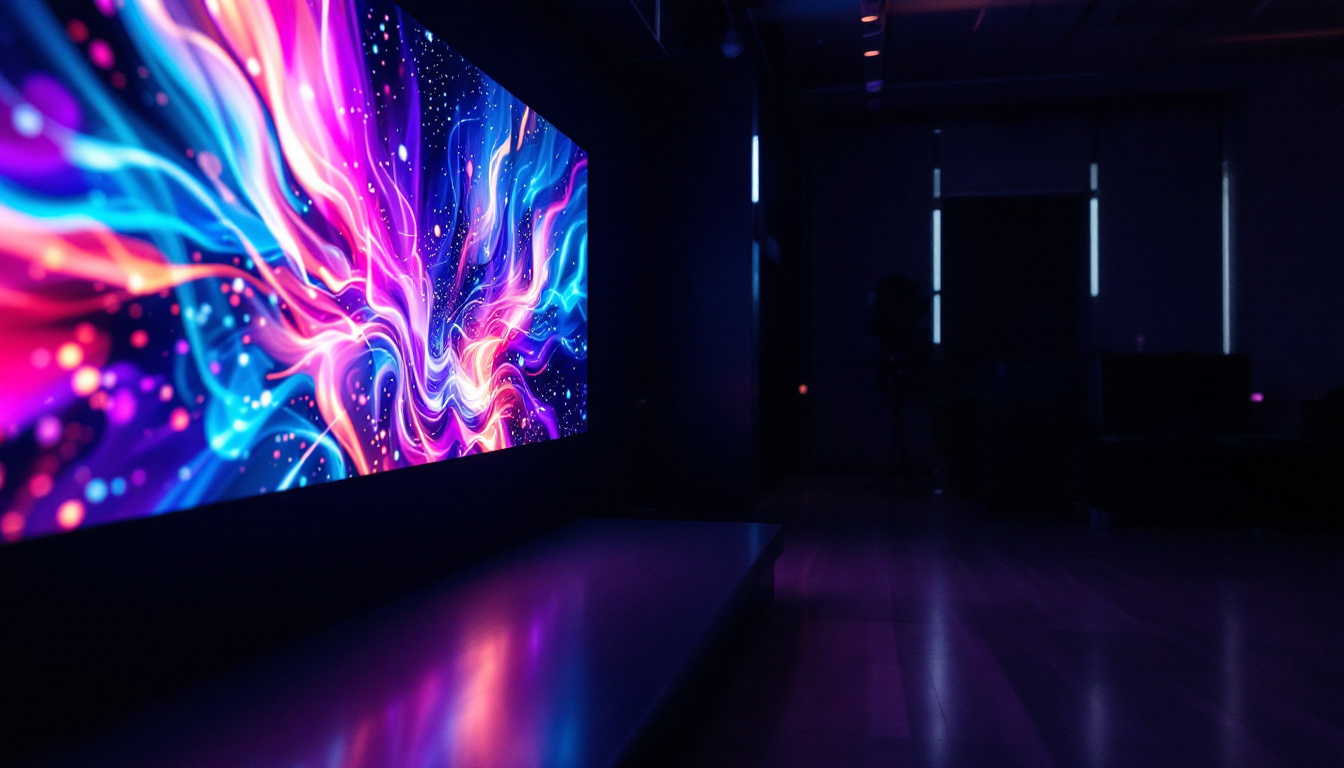The evolution of display technology has brought forth innovations that not only enhance visual experiences but also redefine how we interact with devices. Among these advancements, the transparent OLED touch screen stands out as a remarkable fusion of aesthetics and functionality. This article delves into the intricacies of transparent OLED technology, its applications, and the future it promises.
Understanding OLED Technology
Organic Light Emitting Diode (OLED) technology is a display technology that utilizes organic compounds to emit light when an electric current is applied. Unlike traditional LED displays, which rely on a backlight, OLED screens are self-emissive. This means that each pixel generates its own light, allowing for deeper blacks and more vibrant colors. This self-emissive nature not only enhances the visual experience but also contributes to energy efficiency, as pixels can be turned off completely when displaying black, reducing power consumption significantly.
The Structure of OLED Displays
At the core of OLED technology lies a series of organic layers sandwiched between two electrodes. When electricity flows through these layers, they emit light. The layers include:
- Emissive Layer: This layer is responsible for light emission and is made of organic materials that emit different colors.
- Conductive Layer: This layer helps in transporting electrons to the emissive layer.
- Substrate: The substrate provides structural support and can be made from glass or flexible materials.
This unique structure allows OLED displays to be thinner, lighter, and more flexible than traditional LCDs, paving the way for innovative applications such as transparent displays. Moreover, the flexibility of OLED technology has opened doors to new design possibilities, allowing manufacturers to create curved and foldable screens that adapt to various environments and user needs. This adaptability is particularly appealing in the smartphone and wearable device markets, where form factor plays a crucial role in consumer choice.
Advantages of OLED Technology
OLED technology offers several advantages over conventional display technologies, making it a preferred choice for modern applications:
- Superior Color Accuracy: OLED displays provide a wider color gamut and more accurate color reproduction.
- high contrast ratios: The ability to turn off individual pixels results in true blacks and exceptional contrast.
- Wide Viewing Angles: OLED screens maintain color and brightness consistency across a wide range of viewing angles.
In addition to these benefits, OLED technology is also known for its rapid response times, which significantly reduce motion blur during fast-paced video playback or gaming. This characteristic makes OLED displays particularly attractive for gamers and movie enthusiasts who seek an immersive viewing experience. Furthermore, the thin profile of OLED screens allows for sleek designs in televisions and monitors, enhancing the aesthetic appeal of modern living spaces. As OLED technology continues to evolve, we can expect even more advancements that will further enhance its performance and applications in various fields, including automotive displays and smart home devices.
What is a Transparent OLED Touch Screen?
A transparent OLED touch screen is a display technology that combines the benefits of OLED with transparency. This innovative design allows users to see through the screen while still interacting with touch-sensitive elements. The transparent nature of the display opens up a plethora of possibilities for applications in various fields, from advertising to advanced user interfaces in smart devices.
How Transparent OLED Works
Transparent OLED displays function similarly to traditional OLED screens but with a few key differences. The transparent OLED consists of a transparent substrate, often made of glass or plastic, that allows light to pass through. The organic layers are designed to emit light while maintaining transparency, enabling users to see objects behind the screen. This unique construction not only enhances the visual experience but also allows for energy-efficient operation, as OLED technology is known for its low power consumption compared to traditional LCDs.
When a user interacts with the touch-sensitive surface, the display can recognize gestures and inputs, allowing for a seamless blend of the digital and physical worlds. This interaction is facilitated by capacitive touch technology, which detects changes in capacitance when a finger touches the screen. Additionally, advancements in gesture recognition software are paving the way for more intuitive interactions, enabling users to control devices with simple hand movements, further enhancing the user experience.
Applications of Transparent OLED Touch Screens
The versatility of transparent OLED touch screens makes them suitable for a wide range of applications:
- retail displays: Transparent OLED screens can be used in storefronts to showcase products while allowing customers to see through the display. This not only attracts attention but also creates an immersive shopping experience, as customers can interact with digital content while still being aware of their surroundings.
- Automotive Interfaces: In cars, these displays can provide information without obstructing the driver’s view, enhancing safety and aesthetics. Imagine a dashboard that overlays navigation instructions directly onto the road ahead, allowing drivers to keep their focus on the driving experience while still receiving crucial information.
- Smart Home Devices: Transparent displays can be integrated into home appliances, providing information while maintaining a sleek design. For instance, a refrigerator with a transparent OLED screen could display recipes or nutritional information while allowing users to see the contents inside without opening the door.
Moreover, the potential for transparent OLED technology extends into the realm of augmented reality (AR). By integrating these displays into AR glasses or headsets, users could interact with digital overlays in their real environment, creating a more engaging and interactive experience. This could revolutionize fields such as education, where students could visualize complex concepts in real-time, or in healthcare, where surgeons could access vital information during procedures without diverting their attention from the task at hand.
Advantages of Transparent OLED Touch Screens
The transparent OLED touch screen technology offers numerous benefits that make it an attractive option for various industries:
Enhanced User Experience
By allowing users to see through the display, transparent OLED screens create an immersive experience. This feature is particularly beneficial in retail environments where product visibility is crucial. Customers can view products while interacting with digital information, enhancing engagement and driving sales.
Space Efficiency
Transparent displays can be integrated into existing spaces without requiring additional room for bulky screens. This is especially advantageous in urban environments where space is at a premium. The sleek design of transparent OLED screens allows for creative installations in various settings, from museums to corporate offices.
Energy Efficiency
Transparent OLED displays are generally more energy-efficient than traditional displays. Since they can turn off individual pixels, they consume less power when displaying dark images. This energy efficiency is not only beneficial for the environment but also reduces operational costs for businesses.
Challenges in Transparent OLED Technology
Despite the numerous advantages, transparent OLED technology faces several challenges that need to be addressed for broader adoption.
Manufacturing Complexities
The production of transparent OLED displays is more complex than traditional displays. The materials used must be carefully selected to ensure transparency while maintaining performance. This complexity can lead to higher manufacturing costs, which may deter some manufacturers from adopting the technology.
Durability Concerns
Transparent OLED screens are often more fragile than their opaque counterparts. The materials used in their construction can be susceptible to scratches and damage. Manufacturers are continually working on improving the durability of these displays, but this remains a challenge in the current market.
Limited Brightness
While transparent OLED displays offer stunning visuals, they may struggle with brightness levels in brightly lit environments. The transparency can limit the intensity of the emitted light, making it difficult to see the display in direct sunlight. This limitation poses a challenge for outdoor applications where visibility is crucial.
The Future of Transparent OLED Touch Screens
The future of transparent OLED touch screens looks promising, with ongoing research and development aimed at overcoming current challenges. As technology advances, several trends are likely to shape the future landscape of transparent displays.
Advancements in Material Science
Researchers are exploring new materials that can enhance the performance of transparent OLED displays. Innovations in organic compounds may lead to improved light emission, durability, and energy efficiency. These advancements could result in more robust and versatile transparent displays suitable for a wider range of applications.
Integration with Augmented Reality
The integration of transparent OLED displays with augmented reality (AR) technology holds significant potential. By overlaying digital information onto the real world, these displays can create immersive experiences in various fields, including education, healthcare, and entertainment. The combination of AR and transparent displays could revolutionize how users interact with their environments.
Smart City Applications
As cities become smarter, the need for innovative display solutions will increase. Transparent OLED touch screens can play a vital role in smart city infrastructure, providing real-time information in public spaces. From interactive kiosks to smart signage, these displays can enhance urban living by delivering relevant data while maintaining aesthetic appeal.
Conclusion
The transparent OLED touch screen represents a significant leap forward in display technology, merging aesthetics with functionality. Its ability to provide an immersive experience while allowing visibility of the physical world opens up new possibilities across various industries. Despite the challenges it faces, ongoing advancements in material science and technology promise to enhance its performance and broaden its applications.
As the demand for innovative display solutions grows, transparent OLED technology is poised to become a staple in the future of interactive displays. With its unique features and potential applications, it is an exciting area to watch as it continues to evolve.
Discover the Future of Display Technology with LumenMatrix
Embrace the cutting-edge of transparent OLED touch screen technology with LumenMatrix, where innovation meets practicality. As a pioneer in LED display solutions, LumenMatrix offers a diverse range of products designed to transform your visual communication and engagement. From captivating Indoor and Outdoor LED Wall Displays to dynamic Vehicle and Sports LED Displays, each solution is crafted to elevate your brand’s presence. Experience the synergy of design and technology with our LED Transparent Displays that promise to revolutionize your space. Check out LumenMatrix LED Display Solutions today and step into a world where your message shines with unparalleled clarity and impact.































